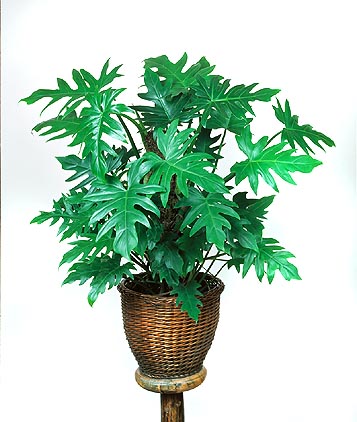Family : Araceae

Text © Pietro Puccio

English translation by Mario Beltramini

Philodendron pinnatifidum © Giuseppe Mazza
The Philodendron pinnatifidum – (Jacq.) Schott (1829) is native to the humid forests of Venezuela.
The name of the genus is the combination of the Greek words “philos” = friend, and “dendron” = tree, with reference to the usual climbing appearance of the plants belonging to this genus; the name of the species is the combination of the Latin words “pinnatus” = pinnate, and “fidus”, from the verb “findere” = divide, with reference to the form of the leaf.
Common names: “fernleaf philodendron” (English); “philodendron fougère” (French).
Perennial evergreen plant, hemiepiphytic, it forms a fleshy stem, which becomes semi-woody with the age, on which are evident the scars left by the fallen leaves, with several robust aerial roots which contribute in keeping it erect; when close to trees where to lean, it can reach the height of some meters by clinging with the aerial roots.
The leaves, of a glossy intense green colour, on long petiole with brown red dots, are almost whole in the young plants, in the adult ones, they are ovate-sagittate, deeply and regularly carved, 40-50 cm long and even more in the older specimen.
The axillar inflorescences are formed by a spadix long about 18 cm, surrounded by a spathe, bulbous at its base, long up to 20 cm, and of a greenish white colour with purple red dots. The flowers are protogynous unisexual (the female flowers are receptive before the ripening of the male flowers, thus avoiding self-fertilization), in particular the male ones occupy the upper part of the spadix, the female ones are grouped in the lower part.
It easily reproduces by air layering and by portions of stem, and by seed too. Not much cultivated plant, either as outer spaces plant in the tropical and humid subtropical regions, or in pot for indoor decoration, replaced long ago by the Philodendron bipinnatifidum, which has similar cultivation requirements, that is, very luminous position, draining and rich of organic substance porous substrata, and frequent watering, but without stagnations, in summer, and reduced watering in winter.
All the parts of the plant contain toxic substances, in particular, calcium oxalate, which can be cause of irritations.
Synonyms: Arum pinnatifidum Jacq. (1797); Caladium pinnatifidum (Jacq.) Willd. (1805); Philodendron pinnatifidum var. virescens K.Koch (1853); Philodendron rubropunctatum Hook.f. (1872); Philodendron pinnatifidum var. rubropunctatum (Hook.f.) Engl. (1878).
